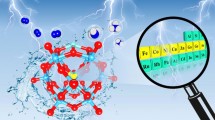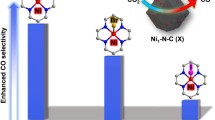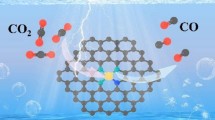Abstract
The breaking of nonpolar N≡N bond of dinitrogen is the biggest dilemma for electrocatalytic nitrogen reduction reaction (NRR) application, driving electron migration between catalysts and N≡N bond (termed “π back-donation” process) is crucial for attenuating interfacial energy barrier but still remains challenging. Herein, using density functional theory calculations, we revealed that constructing a unique hetero-dicationic Mo4+-Mo6+ pair could effectively activate N≡N bond with a lying-down chemisorption configuration by an asymmetrical “π back-donation” process. As a proof-of-concept demonstration, we synthesized MoO2@MoO3 heterostructure with double Mo sites (Mo4+-Mo6+), which are embedded in graphite, for electrochemical nitrogen reduction. Impressively, this hetero-dicationic Mo4+-Mo6+ pair catalysts display more excellent catalytic performance with a high NH3 yield (60.9 µg·h−1·mg−1) and Faradic efficiency (23.8%) as NRR catalysts under ambient conditions than pristine MoO2 and MoO3. Operando characterizations using synchrotron-based spectroscopic techniques identified the emergence of a key ⋆N2Hy intermediate on Mo sites during NRR, which indicates that the Mo sites are active sites and the NRR process tends to follow an associative mechanism. This novel type of hetero-dicationic catalyst has tremendous potential as a new class of transition metal-based catalysts with promising applications in electrocatalysis and catalysts for energy conversion and storage.

Similar content being viewed by others
References
Suryanto, B. H. R.; Du, H. L.; Wang, D. B.; Chen, J.; Simonov, A. N.; MacFarlane, D. R. Challenges and prospects in the catalysis of electroreduction of nitrogen to ammonia. Nat. Catal. 2019, 2, 290–296.
Ye, T. N.; Park, S. W.; Lu, Y. F.; Li, J. F.; Sasase, M.; Kitano, M.; Tada, T.; Hosono, H. Vacancy-enabled N2 activation for ammonia synthesis on an Ni-loaded catalyst. Nature 2020, 583, 391–395.
Han, G. F.; Li, F.; Chen, Z. W.; Coppex, C.; Kim, S. J.; Noh, H. J.; Fu, Z. P.; Lu, Y. L.; Singh, C. V.; Siahrostami, S. et al. Mechanochemistry for ammonia synthesis under mild conditions. Nat. Nanotechnol. 2020, 16, 325–330.
Licht, S.; Cui, B. C.; Wang, B. H.; Li, F. F.; Lau, J.; Liu, S. Z. Ammonia synthesis by N2 and steam electrolysis in molten hydroxide suspensions of nanoscale Fe2O3. Science 2014, 345, 637–640.
Soloveichik, G. Electrochemical synthesis of ammonia as a potential alternative to the Haber-Bosch process. Nat. Catal. 2019, 2, 377–380.
Gong, Y. T.; Wu, J. Z.; Kitano, M.; Wang, J. J.; Ye, T. N.; Li, J.; Kobayashi, Y.; Kishida, K.; Abe, H.; Niwa, Y. et al. Ternary intermetallic LaCoSi as a catalyst for N2 activation. Nat. Catal. 2018, 1, 178–185.
Martín, A. J.; Shinagawa, T.; Pérez-Ramírez, J. Electrocatalytic reduction of nitrogen: From haber-bosch to ammonia artificial leaf. Chem 2019, 5, 263–283.
Howard, J. B.; Rees, D. C. How many metals does it take to fix N2? A mechanistic overview of biological nitrogen fixation. Proc. Natl. Acad. Sci. USA 2006, 103, 17088–17093.
Chalk, P. M.; He, J. Z.; Peoples, M. B.; Chen, D. L. 15N2 as a tracer of biological N2 fixation: A 75-year retrospective. Soil Biol. Biochem. 2017, 106, 36–50.
Deng, J.; Iñiguez, J. A.; Liu, C. Electrocatalytic nitrogen reduction at low temperature. Joule 2018, 2, 846–856.
Yu, X. M.; Han, P.; Wei, Z. X.; Huang, L. S.; Gu, Z. X.; Peng, S. J.; Ma, J. M.; Zheng, G. F. Boron-doped graphene for electrocatalytic N2 reduction. Joule 2018, 2, 1610–1622.
Hu, X.; Sun, Y.; Guo, S.; Sun, J.; Fu, Y.; Chen, S.; Zhang, S.; Zhu, J. Identifying electrocatalytic activity and mechanism of Ce1/3NbO3 perovskite for nitrogen reduction to ammonia at ambient conditions. Appl. Catal. B. 2021, 280, 119419.
Ma, Y. Y.; Yang, T.; Zou, H. Y.; Zang, W. J.; Kou, Z. K.; Mao, L.; Feng, Y. P.; Shen, L.; Pennycook, S. J.; Duan, L. L. et al. Synergizing mo single atoms and Mo2C nanoparticles on CNTs synchronizes selectivity and activity of electrocatalytic N2 reduction to ammonia. Adv. Mater. 2020, 32, 2002177.
Cheng, H.; Ding, L. X.; Chen, G. F.; Zhang, L. L.; Xue, J.; Wang, H. H. Molybdenum carbide nanodots enable efficient electrocatalytic nitrogen fixation under ambient conditions. Adv. Mater. 2018, 30, 1803694.
Yu, B.; Li, H.; White, J.; Donne, S.; Yi, J. B.; Xi, S. B.; Fu, Y.; Henkelman, G.; Yu, H.; Chen, Z. L. et al. Tuning the catalytic preference of ruthenium catalysts for nitrogen reduction by atomic dispersion. Adv. Funct. Mater. 2020, 30, 1905665.
Geng, Z. G.; Liu, Y.; Kong, X. D.; Li, P.; Li, K.; Liu, Z. Y.; Du, J. J.; Shu, M.; Si, R.; Zeng, J. Achieving a record-high yield rate of 120.9 \(\mu {{\rm{g}}_{{\rm{N}}{{\rm{H}}_3}}} \cdot {\rm{m}}{{\rm{g}}_{{\rm{cat}}.}}^{ - 1} \cdot {{\rm{h}}^{ - 1}}\) for N2 electrochemical reduction over Ru single-atom catalysts. Adv. Mater. 2018, 30, 1803498.
Liu, Y. T.; Chen, X. X.; Yu, J. Y.; Ding, B. Carbon-nanoplated CoS@TiO2 nanofibrous membrane: An interface-engineered heterojunction for high-efficiency electrocatalytic nitrogen reduction. Angew. Chem., Int. Ed. 2019, 58, 18903–18907.
Hao, Y. C.; Guo, Y.; Chen, L. W.; Shu, M.; Wang, X. Y.; Bu, T. A.; Gao, W. Y.; Zhang, N.; Su, X.; Feng, X. et al. Promoting nitrogen electroreduction to ammonia with bismuth nanocrystals and potassium cations in water. Nat. Catal. 2019, 2, 448–456.
Lin, Y. X.; Zhang, S. N.; Xue, Z. H.; Zhang, J. J.; Su, H.; Zhao, T. J.; Zhai, G. Y.; Li, X. H.; Antonietti, M.; Chen, J. S. Boosting selective nitrogen reduction to ammonia on electron-deficient copper nanoparticles. Nat. Commun. 2019, 10, 4380.
Chen, G. F.; Yuan, Y. F.; Jiang, H. F.; Ren, S. Y.; Ding, L. X.; Ma, L.; Wu, T. P.; Lu, J.; Wang, H. H. Electrochemical reduction of nitrate to ammonia via direct eight-electron transfer using a copper-molecular solid catalyst. Nat. Energy 2020, 5, 605–613.
Wang, Y.; Wang, D. S.; Li, Y. D. Rational design of single-atom site electrocatalysts: From theoretical understandings to practical applications. Adv. Mater. 2021, 33, 2008151.
Yang, X.; Sun, S.; Meng, L.; Li, K.; Mukherjee, S.; Chen, X.; Lv, J.; Liang, S.; Zang, H.-Y.; Yan, L.-K.; Wu, G. Molecular single iron site catalysts for electrochemical nitrogen fixation under ambient conditions. Appl. Catal. B. 2021, 285, 119794.
Légaré, M. A.; Bélanger-Chabot, G.; Dewhurst, R. D.; Welz, E.; Krummenacher, I.; Engels, B.; Braunschweig, H. Nitrogen fixation and reduction at boron. Science 2018, 359, 896–900.
Huang, L. S.; Gu, X. L.; Zheng, G. F. Tuning active sites of MXene for efficient electrocatalytic N2 fixation. Chem 2019, 5, 15–17.
Zhao, J. X.; Chen, Z. F. Single Mo atom supported on defective boron nitride monolayer as an efficient electrocatalyst for nitrogen fixation: A computational study. J. Am. Chem. Soc. 2017, 139, 12480–12487.
Cao, N.; Chen, Z.; Zang, K. T.; Xu, J.; Zhong, J.; Luo, J.; Xu, X.; Zheng, G. F. Doping strain induced Bi-Ti3+ pairs for efficient N2 activation and electrocatalytic fixation. Nat. Commun. 2019, 10, 2877.
Hohenberg, P.; Kohn, W. Inhomogeneous electron gas. Phys. Rev. 1964, 136, B864–B871.
Kohn, W.; Sham, L. J. Self-consistent equations including exchange and correlation effects. Phys. Rev. 1965, 140, A1133–A1138.
Kresse, G.; Furthmüller, J. Efficient iterative schemes for ab initio total-energy calculations using a plane-wave basis set. Phys. Rev. B 1996, 54, 11169–11186.
Blöchl, P. E. Projector augmented-wave method. Phys. Rev. B 1994, 50, 17953–17979.
Kresse, G.; Joubert, D. From ultrasoft pseudopotentials to the projector augmented-wave method. Phys. Rev. B 1999, 59, 1758–1775.
Perdew, J. P.; Burke, K.; Ernzerhof, M. Generalized gradient approximation made simple. Phys. Rev. Lett. 1996, 77, 3865–3868.
Grimme, S.; Ehrlich, S.; Goerigk, L. Effect of the damping function in dispersion corrected density functional theory. J. Comput. Chem. 2011, 32, 1456–1465.
Moellmann, J.; Grimme, S. DFT-D3 study of some molecular crystals. J. Phys. Chem. C 2014, 118, 7615–7621.
Jauhiainen, J.; Kivimaki, A.; Aksela, S.; Sairanen, O. P.; Aksela, H. Auger and coster-kronig decay of the 3p hole states in krypton. J. Phys. B 1995, 28, 4091–4100.
Ahn, E.; Lee, J.; Koh, Y. Y.; Lee, J.; Park, B. G.; Kim, J. Y.; Lee, I.; Lee, C. W.; Jeen, H. Low temperature nanoscale oxygen-ion intercalation into epitaxial MoO2 thin films. J. Phys. Chem. C 2017, 121, 3410–3415.
Thakur, P.; Cezar, J. C.; Brookes, N. B.; Choudhary, R. J.; Prakash, R.; Phase, D. M.; Chae, K. H.; Kumar, R. Direct observation of oxygen induced room temperature ferromagnetism in MoO2 thin films by X-ray magnetic circular dichroism characterizations. Appl. Phys. Lett. 2009, 94, 062501.
Frati, F.; Hunault, M. O. J. Y.; de Groot, F. M. F. Oxygen k-edge X-ray absorption spectra. Chem. Rev. 2020, 120, 4056–4110.
Zandi, O.; Hamann, T. W. Determination of photoelectrochemical water oxidation intermediates on haematite electrode surfaces using operando infrared spectroscopy. Nat. Chem. 2016, 8, 778–783.
Yao, Y.; Zhu, S. Q.; Wang, H. J.; Li, H.; Shao, M. H. A spectroscopic study on the nitrogen electrochemical reduction reaction on gold and platinum surfaces. J. Am. Chem. Soc. 2018, 140, 1496–1501.
Mitri, E.; Barbieri, L.; Vaccari, L.; Luchinat, E. 15N isotopic labelling for in-cell protein studies by NMR spectroscopy and single-cell ir synchrotron radiation FTIR microscopy: A correlative study. Analyst 2018, 143, 1171–1181.
Yamanari, T.; Kimura, Y.; Mizusawa, N.; Ishii, A.; Ono, T. A. Midto low-frequency fourier transform infrared spectra of s-state cycle for photosynthetic water oxidation in synechocystis sp. PCC 6803. Biochemistry 2004, 43, 7479–7490.
Wang, F.; Liu, Y. P.; Zhang, H.; Chu, K. CuO/graphene nanocomposite for nitrogen reduction reaction. ChemCatChem 2019, 11, 1441–1447.
Nørskov, J. K.; Rossmeisl, J.; Logadottir, A.; Lindqvist, L.; Kitchin, J. R.; Bligaard, T.; Jónsson, H. Origin of the overpotential for oxygen reduction at a fuel-cell cathode. J. Phys. Chem. B 2004, 108, 17886–17892.
Tao, H. C.; Choi, C.; Ding, L. X.; Jiang, Z.; Han, Z. S.; Jia, M. W.; Fan, Q.; Gao, Y. N.; Wang, H. H.; Robertson, A. W. et al. Nitrogen fixation by Ru single-atom electrocatalytic reduction. Chem 2019, 5, 204–214.
Zhang, L.; Ji, X. Q.; Ren, X.; Ma, Y. J.; Shi, X. F.; Tian, Z. Q.; Asiri, A. M.; Chen, L.; Tang, B.; Sun, X. P. Electrochemical ammonia synthesis via nitrogen reduction reaction on a MoS2 catalyst: Theoretical and experimental studies. Adv. Mater. 2018, 30, 1800191.
Acknowledgements
This work was financially supported by the National Natural Science Foundation of China (Nos. 11975234, 11775225, 12075243, and 12005227), the Users with Excellence Program of Hefei Science Center CAS (Nos. 2021HSC-UE002, 2020HSC-UE002, and 2019HSC-UE002), the Innovative Program of Development Foundation of Hefei Center for Physical Science and Technology (No. 2020HSC-CIP013), the Postdoctoral Science Foundation of China (Nos. 2019M662202, 2020M682041, and 2020TQ0316), the Fundamental Research Funds for the Central Universities (No. WK2310000103), The support from the Ministry of Science and Technology of China (No. 2017YFA0204904) is gratefully acknowledged. The numerical calculations in this paper have been done on the supercomputing system in the Supercomputing Center of University of Science and Technology of China. This work was partially carried out at the USTC Center for Micro and Nanoscale Research and Fabrication. The authors would like to thank BSRF, SSRF and NSRL for the synchrotron beamtime.
Author information
Authors and Affiliations
Corresponding authors
Additional information
Electronic Supplementary Material Asymmetrical π back-donation of hetero-dicationic Mo4+-Mo6+ pairs for enhanced electrochemical nitrogen reduction
Electronic Supplementary Material
Rights and permissions
About this article
Cite this article
Tan, H., Ji, Q., Wang, C. et al. Asymmetrical π back-donation of hetero-dicationic Mo4+-Mo6+ pairs for enhanced electrochemical nitrogen reduction. Nano Res. 15, 3010–3016 (2022). https://doi.org/10.1007/s12274-021-3934-6
Received:
Revised:
Accepted:
Published:
Issue Date:
DOI: https://doi.org/10.1007/s12274-021-3934-6




